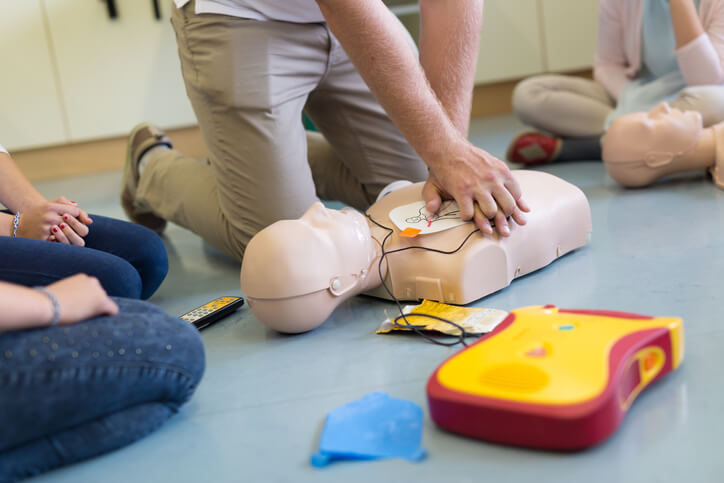
Training is an essential part of your job. With the demands of your work schedule, spending time with your family, and your daily obligations, you may find yourself struggling to find the motivation to put in extra time for training. But even the most skilled practitioners need to train—and train often—to best serve their patients when airway emergencies occur.
The truth is that you should be constantly training for the unknown. EMS is unpredictable, and your training should revolve around this concept. Here, we discuss a few airway management scenarios you can focus on in your next training to keep your skills fresh and your mind focused on the various airway emergencies you may encounter.
1. Multiple casualty incident
In a multiple casualty incident (MCI), you are only one link in a chain of responders, which could be very large.
However, one weak link can break the chain.
The major hurdle in MCIs is efficient, thorough, and rapid triage. Triage methods and techniques need to be refreshed frequently so you remember how to quickly use them. Ideally, triage training drills should involve both EMS and hospital personnel. Triage training provides an opportunity to discuss and practice patient assessment skills. Training should involve various patient scenarios and should cover several areas, including:
- Quickly locating and using various triage tools, such as triage tags
- Bridging communication gaps between EMS agencies and hospital providers
- Identifying problems and solutions to various incidences before they occur
Specific airway management scenarios with MCIs may include mass shootings or terrorism, requiring the use of tactical airway management tools that can easily be transported to the scene of the emergency.
2. Unresponsive patient
In this scenario, you may be called simply for a “man down” or an unresponsive patient. You need to be prepared at all times to run into a situation that requires thorough suctioning; sometimes you will need to remove copious amounts of vomit or contaminants at a moment’s notice. Training for these scenarios involves being exposed to both medical and trauma situations that could lead to altered levels of consciousness for your patient, including:
- Substance overdose
- Cardiac or respiratory arrest
- Stroke
- Choking
- Diabetic emergency
In these scenarios, you always fall back on your ABCs—always start with the airway. Airway management for these patients will vary widely. These patients may or may not be breathing on their own and they may have large amounts of secretions to clear from their airway. Secretions and contaminants left in their airway for any length of time may lead to aspiration pneumonia, a life-threatening complication that may be preventable if you are able to clear their airway in time.
Consider training using innovative techniques to keep your airway management skills fresh. One technique, the suction-assisted laryngoscopy and airway decontamination (SALAD) method, using the SSCOR SDC Catheter™ (Formerly the SSCOR DuCanto Catheter®).
The SALAD technique involves constant suction of airway contaminants to clear the airway for an artificial airway and to reduce the risk of aspiration pneumonia. Like other EMS skills, the SALAD technique takes time to perfect and master. However, with practice, you will see that it prepares you for the unpredictable nature of EMS airway management scenarios.
3. Pediatric airway emergency
Any call involving a child may make the hairs on your neck stand up. It is pretty much a universal feeling—it means added stress all around.
Here’s where your training comes into play. Seeing and treating pediatrics with airway emergencies for the first time in an actual call is far scarier than in a controlled training environment. Get your nerves and your mistakes out of the way in training and learn from your peers! Training for airway emergencies involving children may include:
- Allergic or anaphylactic reactions
- Trauma
- Cardiac arrest
- Croup or epiglottitis
Remember to have different sizes of certain equipment on hand to accommodate your pediatric patients. Store your various disposables with your suction unit so they are easily accessible when you need them. Also, be sure to train on the same equipment that you use in the field—ideally, suction units with easily adjustable suction pressures for pediatric patients. Using the same equipment in training as you use in the field will give you the confidence you need for pediatric airway emergency situations.
The Most Important Part of Training: Be Willing to Learn
Emergency medicine is always evolving and can change at a moment’s notice. Prepare yourself for this by being open to training, even if you feel your skills are well-established. Your coworkers, community, and patients demand and deserve this from you. Be well-equipped to meet all of these demands by practicing these various scenarios, and the next time you face an airway management emergency, you will have the confidence and the skills to best serve your patients.
Editor's Note: This blog was originally published in June 2022. It has been re-published with additional up-to-date content.















